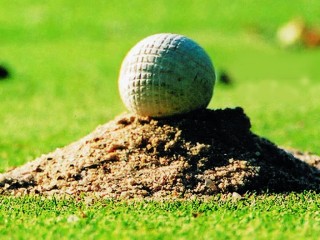TEE 1. teeing point from which the first impact on the hole is made.2. plastic or wooden pin. Used to place the ball on the tee or as a ball marker when picking up the ball.
Who invented golf tee? A brief cultural history of the golf tee

In the times before Dr. Lowell came up with the idea of birchwood teas, piles of sand were simply used as teeing aids. The name “tea” is said to come from the Dutch, where the pile of earth was called “tuidje”.
Even in the early days of golf, players found it easier to hit the ball from a small elevation. Therefore, the ball was placed on a small pile of earth at each tee.
For many golfers this procedure became too cumbersome and so they started very early to look for a “portable” substitute for the “tees” made of sand or earth.
The first record of a golf tee is a patent from 1889, which consisted of a rubber plate on which a cylindrical elevation is placed on which the ball is placed. The tee was simply placed on the ground. Many of the early tees resemble this system.
In 1890, the first advertisements appeared in British golf newspapers. In contrast to the tees from Bloxsom and Douglas, the tees offered here could be put into the ground. One such tee was the “Perfectum”, an iron plug with a rubber ring crowned with a head of upright rubber pins. Its inventor was Percy Ellis of Surrey, who registered the British patent in 1892.
In 1897, “Victor” tea was invented by the Scotsman PM Matthews. It consists of an iron shaft and a rubber head. The rubber was intended to protect the club and not disturb the stroke.
One of the first Harvard dental graduates, Dr. George Grant, is another early tea designer. His tea version was patented in 1899 and consists of a vertical rubber tube attached to a pointed piece of wood at its base.
At the turn of the century, there were a number of other inventions. However, none of them could prevail and replace the old tradition of the “pile of sand”.
This only changed in 1920 when a dentist from Maplewood, New Jersey, William Lowell, patented a tea that became the standard. The wooden tea has a funnel-shaped head, a concave surface and a narrow trunk. The “Reddy Tea”, as Lowell called it, can be produced easily and cheaply and was introduced with a marketing campaign,
Together with Spalding the production was started and already one year later an unbelievable profit of 100.000 dollars was made. However, the blessing with the small red wooden pencils did not last long, the dispute over patent rights raged for over 20 years and finally forced the sons of Dr. Lowell to sell their modest shares, which had shrunk in the meantime.
Because of the great acceptance of the “Reddy Tee”, Dr. Lowell is often mentioned as the inventor of the golf tee, which is certainly not correct considering the earlier patents.
Today there is an almost unmanageable number of different teas. Whether made of wood or plastic, whether long or short or with bristles. Teas are available in almost all variations. You will find a selection on our pages.
Golf Tea Patents
So it was only a matter of time before golf tees were patented. On this page we have compiled a list of the patents in this area.
A good overview of the entire development of the golf tee is given in the book “Singular History of the Golf Tee” by Irwin R. Valenta (Greensboro, N.C. : I.R. Valenta , 1995).
